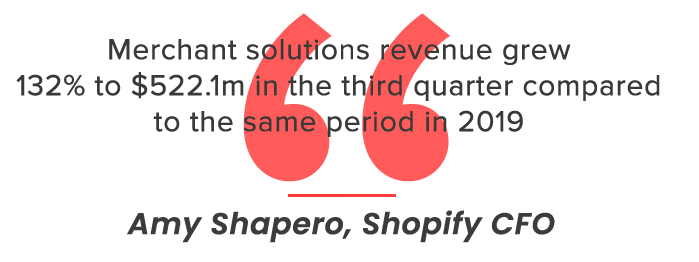
Wednesday, February 17, 2021
Is Shopify Share A Buy After Earnings Release Report?
تم إعداد هذا المنشور من قبل سنشري للاستشارات


Shopify’s [SHOP] share price soared throughout 2020 after its ecommerce platform saw record demand from consumers and businesses that became reliant on its services. Investors will be keen to see how the ecommerce giant has fared ahead of its fourth quarter results on 17 February.
Shopify’s share price fell to $322.29 on 16 March. The stock’s worst day of trading in 2020 was triggered by the coronavirus market sell-off. Within the space of a month, however, the stock had recovered most of its lost value and was up 54.6% for the year to date to 20 April after closing at $629.90. At the time, this was the stock’s highest close on record.
By 1 July, Shopify’s share price had recorded a 156% year-to-date climb to close at $1,016.64. Although the stock has since topped this value, its performance proved volatile for the rest of the year.


December marked the start of another rally, and Shopify’s share price finished the year up 185%. While this was 11.3% lower than its best 2020 close of $1,277.08, the stock has skyrocketed since.
Shopify’s share price set another record by climbing to an intraday high of $1,499.75 on 10 February, before closing at $1,462.42. As of 12 February, the stock was up 28.6% year to date.
How has Shopify’s share price been performing?
When Shopify released its third quarter results on 29 October, it announced earnings of $1.13 per share, more than double the Zacks Equity Research consensus estimate of $0.50 per share. Meanwhile, revenues grew 96% year-over-year to $767.4m, beating the Zacks consensus estimate by 16.9%.
The coronavirus pandemic was undoubtedly a contributing factor to Shopify’s third quarter growth, which was driven by more businesses opening virtual stores as well as an increase in online spending.
“Merchant solutions revenue grew 132% to $522.1m in the third quarter compared to the same period in 2019,” Amy Shapero, Shopify’s CFO, said on the earnings call. “This tremendous growth was driven primarily by merchants’ strong sales with GMV [gross merchandise volume] increasing 109% year-over-year to $30.9bn.”


As a cornerstone of ecommerce, Shopify is a key holding in SaaS-focused ETFs, such as the Amplify Online Retail ETF [IBUY]. Although both assets followed a similar price trend at the beginning of 2020, the Amplify Online Retail ETF’s growth lagged behind that of Shopify’s share price, and the ETF finished the year 122.6% up. However, the Amplify Online Retail ETF could be catching up with Shopify — it was up 155% over the last 52-week period (through 12 February), compared to Shopify’s 174%.
Looking ahead to its next earnings report, Shopify is expected to post earnings of $1.21 per share, according to Zacks, which would represent 181.4% year-over-year growth. Revenues, on the other hand, are expected to grow 79.5% from the year-ago period to $906.82m.
Is Shopify a buy?
To encourage wider adoption of its services, Shopify will launch its checkout system, Shop Pay, to some Facebook [FB] platforms, starting with Instagram.
As well as making it easier for consumers to make purchases by saving their card and delivery details, Shop Pay enables customers to track their orders through its app, offers payment instalment plans and promises to offset the carbon emissions associated with deliveries.
According to a report from eMarketer, social commerce — which includes purchases made on social platforms, or by clicking an ad or promotional content on social media — is expected to rise 34.8% in the US to $36.09bn in 2021.
However, Shop Pay’s brand does not stand out enough for significant short-term growth, Jason Goldberg, chief commerce strategy officer at Publicis Groupe SA, told The Wall Street Journal.
“Shopify Pay has some momentum and it’s growing and it’s smart to support, but it’s unlikely to dramatically increase the pool of shoppers on Facebook that are able to pay with a digital wallet,” Goldberg said. “Consumers aren’t likely to pick what they want to buy and how they want to pay for it based on their ability to track those purchases in some third-party app.”


Meanwhile, Brian Schwartz, an analyst at Oppenheimer, believes there are reasons to be bullish on Shopify, according to Barron’s.
He noted that the company is part of a “very large and accelerating market” and that it should be a “rule of 40” company for the foreseeable future — referring to companies that can grow revenue at better than 40% with gross margins above 40%. Schwartz also noted that as the pandemic continues to drive ecommerce, Shopify’s “international opportunity is still ahead.”


Source: This content has been produced by Opto trading intelligence for Century Financial and was originally published on cmcmarkets.com/en-gb/opto
Disclaimer: Past performance is not a reliable indicator of future results.
The material (whether or not it states any opinions) is for general information purposes only and does not take into account your personal circumstances or objectives. Nothing in this material is (or should be considered to be) financial, investment or other advice on which reliance should be placed. No opinion given in the material constitutes a recommendation by Century Financial or the author that any particular investment, security, transaction or investment strategy is suitable for any specific person.
Century Financial does not endorse or offer opinion on the trading strategies used by the author. Their trading strategies do not guarantee any return and Century Financial shall not be held responsible for any loss that you may incur, either directly or indirectly, arising from any investment based on any information contained herein.
















